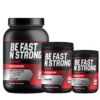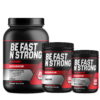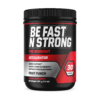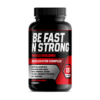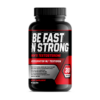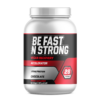Be Fast n Strong Guide to Building Lean Muscle Without Extreme Cutting
Building lean muscle without the need for extreme cutting phases is all about a balanced approach to training, nutrition, and recovery. Here’s a guide to help you achieve that lean, muscular physique while avoiding the common bulking and cutting cycles.
1. Focus on Slow, Steady Muscle Gain
Instead of eating a large calorie surplus that leads to fat gain, aim to increase your calorie intake by about 5-10% above maintenance levels. This slow, steady approach allows your body to build muscle without accumulating excess fat. Gaining 0.25 to 0.5 pounds of muscle per week is ideal for minimizing fat gain during the process .
2. Prioritize Protein Intake
Protein is the key macronutrient for muscle growth. Aim to consume at least 1 gram of protein per pound of body weight daily. High-protein foods such as lean meats, eggs, and plant-based sources (like lentils and tofu) are essential. Incorporating a whey protein supplement can also help you meet your daily protein goals without excessive caloric intake .
3. Use Compound Movements for Maximum Muscle Activation
Perform compound exercises like squats, deadlifts, pull-ups, and bench presses. These exercises engage multiple muscle groups at once, promoting overall strength and muscle growth. Including isolation exercises can further target specific muscles, helping you build a more balanced physique .
4. Manage Carbohydrate and Fat Intake Wisely
Carbohydrates provide the energy needed for intense workouts, but excess carbs can be stored as fat. To prevent this, focus on timing your carb intake around your workouts, when your body can use them most effectively for energy and recovery. Similarly, include healthy fats like avocados and omega-3s, but avoid going overboard, as fats are calorie-dense .
5. Don’t Overdo Cardio
While cardio is beneficial for overall health, excessive cardio can interfere with muscle growth. Instead, focus on short, high-intensity interval training (HIIT) or limit your cardio to maintain cardiovascular health without sacrificing muscle gains .
6. Track Your Progress
It’s crucial to regularly measure your body fat percentage, take progress photos, and track your workouts and diet. This will help you make adjustments to your training or nutrition plan as needed, ensuring you stay on track with your muscle-building goals .
7. Recover Adequately
Rest and recovery are just as important as training. Your muscles need time to repair and grow after workouts. Ensure you’re getting enough sleep and consider active recovery days with light stretching or mobility work .
By following these guidelines, you can build lean muscle efficiently without having to resort to extreme cutting phases. Remember, slow and steady progress leads to sustainable, long-term results.


